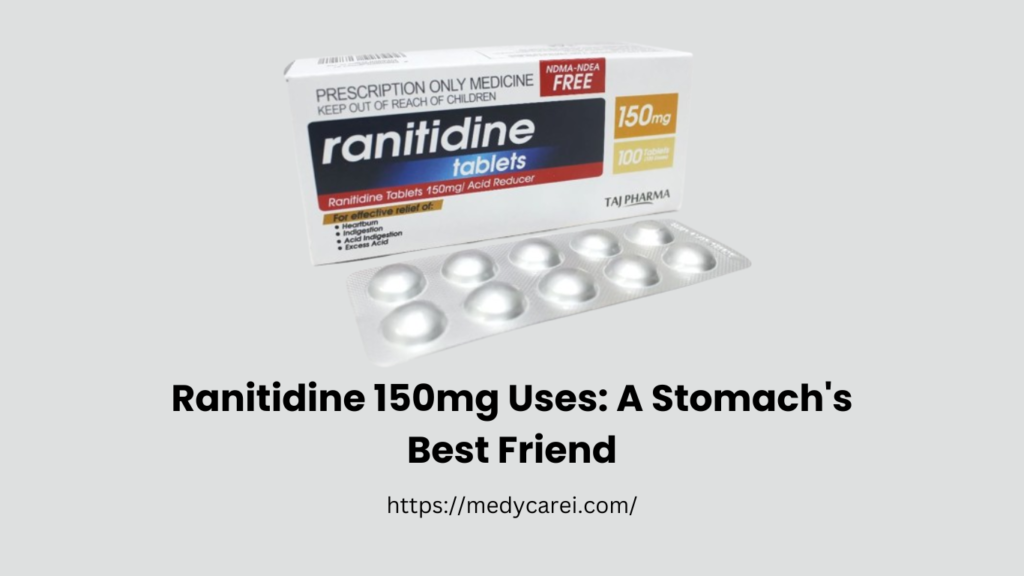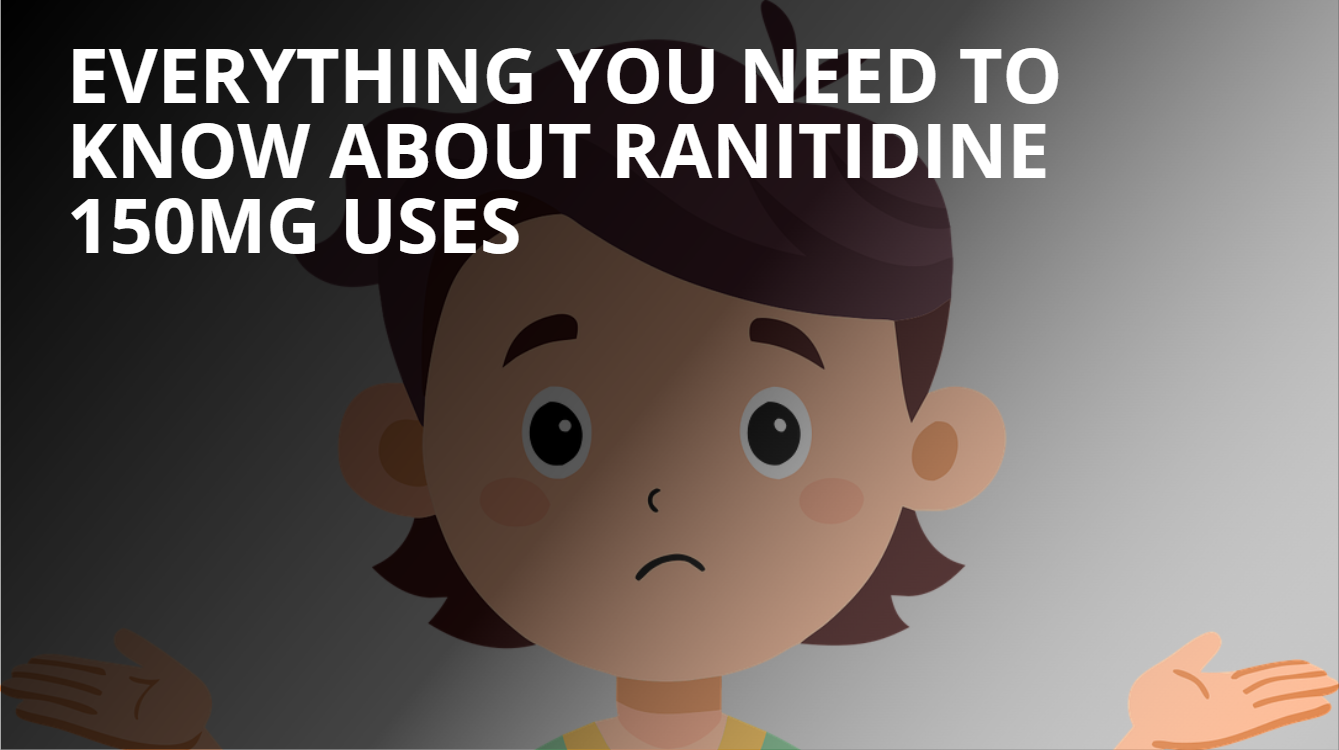So you’ve heard about Ranitidine 150mg, huh? Probably from a friend, a doctor, or perhaps you stumbled upon it while scrolling through that never-ending abyss that is the internet. Well, sit tight because we’re just about to take a deep dive into the world of Ranitidine 150Mg uses. Trust me, it’s going to be a wild ride—oh well, maybe not wild, but definitely informative!
What Is Ranitidine 150mg Anyway ?
But before we get into it and reveal all of the secrets of Ranitidine 150mg uses, let us first discuss what in the world this mysterious little pill actually is. Ranitidine is marketed under brand names such as Zantac and belongs to the medication class known as H2 blockers. No, it is not a type of fancy sci-fi weapon; it is just the name of the drug that helps minimize the amount of acid the stomach makes.
In simpler words, Ranitidine is like the bouncer of your stomach. It will help to keep acid levels in check, the ones that are pretty troublesome. Now, you would ask, “Hey, do I need that?” Now, that’s exactly what we are going to discuss.
Ranitidine 150mg Uses: A Stomach’s Best Friend

1. Heartburn Relief
Let’s face it, heartburn is the absolute worst. It’s like your chest is on fire, and not in a good way. This is where Ranitidine 150mg comes to the rescue. By reducing stomach acid, Ranitidine helps to alleviate the burning sensation in your chest, making you feel human again. It’s like having a tiny firefighter in pill form!
2. Treating Acid Reflux and GERD
If you’ve ever had acid reflux, this is really not something you’d wish on anybody, except maybe your worst enemy. No more of that horrible burning sensation in your chest! Ranitine 150 is commonly administered to help treat acid reflux and Gastroesophageal Reflux Disease, or GERD: it’s just a fancy term for chronic acid reflux. Ranitine achieves this, basically, by lessening the production of acid.
3. Treatment of Gastric Ulcers
Things start to become serious here. Stomach ulcers are the painful sores surrounding the stomach lining; they can be caused by—you guessed it—too much acid in the stomach. Ranitidine 150mg is indicated for the treatment of and prevention from these ulcers by reducing production of acid, thus allowing the lining of the stomach to heal and keeping those ulcers from coming back like an unwanted houseguest.
4. Zollinger-Ellison Syndrome.
Alright, now we’re getting into the really rare stuff. Zollinger-Ellison Syndrome is a disease that causes your stomach to secrete too much acid due to a growth. While this is not likely to be encountered by many folks, in treating the condition Ranitidine 150 mg is often used to help control the overproduction of acid. So it’s like Ranitidine works a second job and is the hired muscle for your stomach in bad cases with this.
5. Preventing Stomach Ulcers in Certain Situations
At times, one is bound to take medications that may pose irritation to the stomach lining, like NSAIDs (nonsteroidal inflammatory drugs — fancy, right?). The use of ranitidine 150 mg would be applied to help prevent forming ulcers in these situations or prevent the possible spreading of ulcers already developing, thus keeping your stomach happy even when you are taking other medicines.
How to Take Ranitidine 150mg: A Quick Guide

Having understood what Ranitidine 150mg is used for, you will now be curious about how one can take Ranitidine 150mg. In most instances, it is always simple. Ranitidine 150mg is administered once or, at times, twice in a day, depending on the indication. Your doctor shall guide you clearly on this, and you must fully follow their directions.
So here’s a little heads-up. Ranitidine can be taken with or without food, so no need to plan your meals around it. Pop the pill and off you go.
And yet there’s more! If your doctor isn’t just using Ranitidine as your get-out-of-jail-free card for breaking all the rules before the acid test, but is prescribing it to help heal damage done by stomach acid, time the dose 30 to 60 minutes before the acid kicks in. It’s your way of signaling your stomach before the acid party starts.
Side Effects: It’s Not All Fun and Games

Like every other drug, Ranitidine 150mg, too, has some side effects. The good news is this: Most people do not go through this, and for those that might, the effects are usually not that serious. Nevertheless, you may want to look out for :
Common Side Effects:
- Headache: Really, who does not love the headache. (I was joking; Nobody does)
Nausea or Vomiting: You may experience these. Dizziness: You may feel as if in a merry-go-round, but certainly, it is not as much fun. Constipation or Diarrhea: Your tract needs some time to adapt. Severe Side Effects—It’s Rare, but It’s Still True Liver Issues: If you start seeing yellow in your skin or in the whites of your eyes, hello jaundice, then it’s time to pick the phone and call the doctor. Allergic Reactions: If your face or body swells, or you develop a rash or difficulties in breathing, do not wait; rush now and get some medical help.
Now, before you start freaking out, keep in mind that most people take Ranitidine without any problems at all. But it’s always good to be informed; you never know.
Ranitidine 150mg: The Recall Drama
You may have heard that some time back, there was a recall for Ranitidine. What was being said, and what does it all really mean? In 2019, it was found that some batches contained NDMA, a substance prepared from N-methyl impurities in the composition of ranitidine. This product is potentially harmful for human beings, if used in larger quantities for a very long period.
As a result, many places pulled Ranitidine off the shelves. However, avoid panicking: if you now take Ranitidine or it is in your medicine cabinet, just talk to your doctor about substituting means. There are many other H2 blockers or proton pump inhibitors (PPIs) available that can do the job just as well.
Alternatives to Ranitidine 150mg

So, what can you do if a 150 mg Ranitidine isn’t available right now or you are a little cautious about it at this time? Here are a few alternatives that just might work out for you:
- Famotidine (Pepcid): Another H2 blocker that works in a similar way to Ranitidine.
- Omeprazole (Prilosec): A proton pump inhibitor (PPI) that reduces stomach acid in a much more potent way.
- Cimetidine (Tagamet): Also an H2 blocker, but it’s a little older and might have more drug interactions.
Your healthcare provider can help you decide which one is best for you based on your particular need.
The Bottom Line on Ranitidine 150mg Uses
There you go—everything you need to know about Ranitidine 150mg uses. This drug has been a major respite for many, ranging from heartburn and acid reflux to a wide variety of ulcers and other severe conditions. Just use your wisdom with this drug, be responsive to the side effects, and keep in touch with your healthcare provider since this recall has been put in place.
Related Topic : How to Use Diphenhydramine for Insomnia Relief
And yeah, in case you feel like your stomach’s planning a revolution, you know where to go now—Ranitidine or its million silhouettes. So, keep conscious, stay healthy, but yes, stomach acid—do maintain its balance.
Disclaimer
The information provided on this blog regarding medicine prices and side effects is solely based on data collected from public domains. I am not a doctor or medical professional. While I strive to provide accurate and up-to-date information, I cannot guarantee the absolute accuracy or completeness of the data. It is always recommended to consult with a qualified healthcare professional or doctor for personalized medical advice and information. The content on this blog should not assume any responsibility for any consequences arising from the use of the information on this blog.
Thank you.
